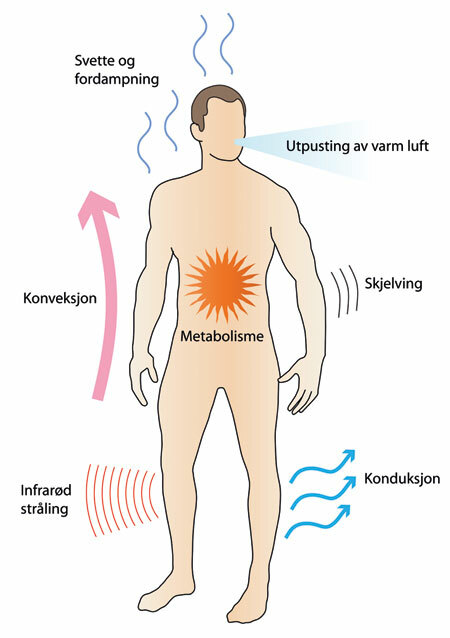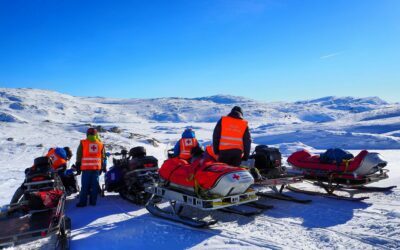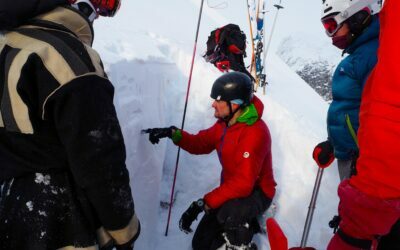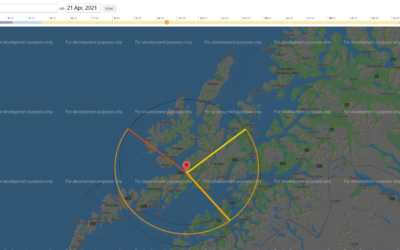Dealing with hypothermia
Hypothermia occurs when the body is exposed to cold, or cannot maintain the production of heat in a cold environment. In accidents that cause unconsciousness, the body’s core temperature can plummet. Hypothermia also occurs among avalanche victims – albeit suffocation and trauma are greater threats there. Moving through the mountains without adequate clothing and planning can have serious consequences. Every year, many have to be rescued by volunteers and rescue teams. There can be many reasons why, but none are adequately protected from the environment. Here we review advice from the Norsk Fjellmedisinsk Selskap (Norwegian Mountain Medicine Society), the rescue services, doctors, and add some of our own, to prevent and treat hypothermia.
Hypothermia (facts)
A person is held to be hypothermic when the body’s core temperature is lower than 35 °C.
| Mild hypothermia (core temp. 35–33° C) | Shivering; increasing lethargy. |
| Moderate hypothermia (core temp. 32–29° C) | Shivering decreases; consciousness threatened; possible hallucinations. |
| Serious hypothermia (core temperature under 28° C) | Trembling ceases; unconsciousness; slow and weak breathing; may be mistaken for dead. Heart rhythm changes; possible cardiac arrest. |
Source: Store medisinske leksion
Treating a hypothermic patient
Responding to someone suffering hypothermia is without doubt challenging. Knowledge of the most important principles is potentially lifesaving. This is just as relevant for us moving through the winter mountains for own pleasure as it is for professional rescue services and guides. The basic method’s the same, whether for an emergency response team treating a sufferer with advanced equipment or for the rest of us, treating a friend. Some familiarity with these relatively simple measures can make a big difference. It’s important to be aware that patients with hypothermia must be treated very carefully, however. If one has no way of taking the sufferer’s temperature, then it’s good practice to assume that the patient is cold or in danger of becoming so.

Norsk Fjellmedisinsk Selskap (NFS)
This article explains practical measures for treating hypothermic people who are not in cardiac arrest – whose blood is circulating. The same procedures function to prevent injured and sick patients in the mountains from freezing. In situations where sufferers are in cardiac arrest or suffering severe hypothermia, more advanced and complicated responses are required.
Checklist for victims of hypothermia
Prevention
Conduction heat loss the ground can be prevented by insulation with sleeping mats, down jackets, sleeping bags, spruce branches or anything else you may have to hand. Get the patient off the ground!
Convection heat loss can be prevented by protection from wind and weather. Shell jacket, tarp, tent fly-sheet or a bivvy bag function excellently.
Radiation heat loss is prevented by covering exposed skin, especially the head. Whatever you have to serve as a hat will do!
Evaporation heat loss can be prevented with a tight vapour barrier around the patient. If nothing else, a plastic sheet will work.
Source: Norsk Fjellmedisinsk Selskap
The four principal causes of heat-loss …
… and how to prevent them.
Managing heat-loss is, of course, entirely central to the treatment of people whose exposure threatens their well-being. The aim is to manage the patient so that they don’t become colder and, of course, to increase the body temperature. To make these measure most effective, some understanding of how body heat is lost to the surroundings is helpful. So it’s worth going into some detail on the most important causes of heat loss and the most effective measures linked to the various underlying causes. Meet conduction, convection, radiation and evaporation.

Source: Head JF, Elliott RL. «Infrared imaging; making progress in fulfilling its promise». & Ring EF, Ammer K. «Infrared thermal imaging in medicine».
Exhaustion – physical and mental
Prevention begins with taking care of yourself. Many accidents, mishaps and injuries (hypothermia among them) occur because people make very simple mistakes with pretty serious consequences. If you don’t take in enough sustenance, dress inadequately, or take ill-thought-out “shortcuts,” the results can be pretty bad. One of the most important preventative measure you can take is simply taking care of yourself.
Get enough nutrition, take in enough energy, drink enough water, get enough rest and be mentally present. If you’re exhausted and run out of energy, your brain doesn’t function optimally either. It can lead to poor choices, or simply sloppiness. Learn to know your body. Pay attention to what it tells you. If you feel it’s time to eat, eat some simple snacks or nuts to be on the safe side. If you notice a slight headache, have something to drink. Act on your body’s feedback before things go wrong. Change into dry clothes as soon as possible. Running out of energy in the winter mountains can have fatal consequences.
Conduction
Explantion
Heat-loss through conduction occurs when we lose heat through contact with something colder than we are – the cold, snow-covered ground, for example. And the greater the contact, the more, and faster, we lose our heat. Water and metal conduct heat quickly. Materials such as foam rubber, down and other insulation, the kids of things we commonly take out on a trip, conduct heat poorly. They’re helpful, then, in preventing or slowing down freezing.
Measures
To stop surfaces “stealing” our heat, insulate patients against them with things such as a sleeping mat, a down jacket, or any other insulating materials you have at hand.

Convection
Explanation
Heat loss from convection occurs through the transfer of heat from one place to another through the movement of currents of air or water. This is typically wind or water. Rain will do it if you aren’t actually submerged. When the body is exposed to wind and water in motion, the body’s heat is carried off as cooler wind or water is replaced at the contact surface. Then the body’s temperature can drop rapidly.
Measures
Heat-loss of this kind is best prevented by isolating the body from the wind or water causing it. In practice, this means seeking shelter or getting a soaked person somewhere dry. It is essential to isolate, cover and protect the afflicted person using something such as a tent, a bivvy bag or extra clothing.

Radiation
Explanation
Heat-loss through radiation is a consequence of the laws of physics – the universe likes equibilrium, basically. Heat radiates from something hot (your body, say) to something cold (like the air). As long as the body’s surroundings are colder than your skin, you’ll be heating it to some degree or other. Eventually you run out of heat. In freezing conditions, that can be a survival issue.
Measures
Dealing with radiated heat-loss begins with dressing appropriately before you head out into the wilds. Use clothing that reflects and retains heat – a shell and an insulation layer – to prevent exposure, limiting heat loss to your surroundings. The greatest heat loss from radiation occurs from the head. Wear a hat. And cover the head of those who are suffering from exposure to cold.

Evaporation
Explanation
Why do we sweat? To cool down.
It requires energy to convert water to vapour – which is what happens when evaporation occurs. If we get wet in a cold environment (with sweat from climbing hills on skis, or drenching by sleet, say) the consequences can be serious. Water conducts heat 25 times faster than air. If your clothes get wet, they won’t insulate you – and heat loss through evaporation will increase enormously.
The body will work overtime to heat the cooling skin. This can lead to hypothermia.
Measures
Dress to stay dry. Ventilate (open zips; take off your neck covering); use layers; change into dry clothes if they get wet. In situtations where hypothermia has begun, a vapour barrier is useful: make sure insulating layers are dry and wrap the sufferer in bubble wrap, plastic refuse, rescue foil or cling film!

A couple of rubbish bags can be good to take with you on a trip. They’re useful for so many things. Emergency tarp, rubbish storage, life-saving vapour barrier… Photo: Crister Næss/ Åsnes

Cling film’s another clever thing to take in your kit. A long length can can be twisted to become a “rope” or a splint for bones. It can serve as a “bandage” in case of bleeding – and an extremely effective vapour barrier for people suffering from exposure to cold! Photo: Crister Næss/Åsnes
“But all this is obvious…”
Yes. Much of this advice seems obvious to the point of being banal. We know to address appropriately when we go to the shops in winter, right? Dressing appropriately for a trip to the wilderness isn’t exactly the apogee of mountaincraft. OK: but hypothermia isn’t “feeling cold” (and, by the way, we’re not likely to break the ice on a frozen river or become hypoglycaemic on the way to the supermarket). Caring for people suffering from hypothermia, our “common knowledge” must coincide with more specialised knowledge of human physiology and the laws of physics if it is to be useful. Åsnes Academy Expert Panel
In practice, heat loss in a patient is alleviated by counteracting the causes of heat loss simultaneously, by wrapping patients properly. Emergency rescue teams in Norway uses a model called the Banak model.
“But all this is obvious…”
Yes. Much of this advice seems obvious to the point of being banal. We know to address appropriately when we go to the shops in winter, right? Dressing appropriately for a trip to the wilderness isn’t exactly the apogee of mountaincraft. OK: but hypothermia isn’t “feeling cold” (and, by the way, we’re not likely to break the ice on a frozen river or become hypoglycaemic on the way to the supermarket). Caring for people suffering from hypothermia, our “common knowledge” must coincide with more specialised knowledge of human physiology and the laws of physics if it is to be useful. Åsnes Academy Expert Panel In practice, heat loss in a patient is alleviated by counteracting the causes of heat loss simultaneously, by wrapping patients properly. Emergency rescue teams in Norway uses a model called the Banak model. .


Gentle handling
When the core temperature drops, major changes in the body’s physiological processes occur. The circulatory and respiratory systems are particularly vulnerable. Several cases have been recorded where patients who are comparatively alert when rescue services arrive lose consciousness and go into cardiac arrest when they’re pulled into a boat or a helicopter. While the exact mechanisms for this haven’t been conclusively identified, it’s probably something to with the balance of salts and waste substances in the body’s extremities suddenly returning to the heart. This makes the management of hypothermic patients complicated. Being as gentle as possible in a situation where a patient must be immediately evacuated from a mountain or frozen water presents problems. The only solution is to find a sensible middle ground: keep the patient lying as horizontal as possible, for example; this improves the prognosis and reduces the risk of cardiac arrest.
Sources
«Hypothermia» – Deranged Physiology (A free online resource for Intensive Care Medicine)
Aksidentell hypotermi – en utfordring for redningstjenesten – Hovedredningssentralen
Ressurser: Hypotermi & «Håndtering av Hypotermi» – Norsk Fjellmedisinsk Selskap
«Hypotermi» – Store Medisinske Leksikon
Nasjonal kompetansetjeneste for traumatologi (NKT-Traume)
Røde Kors v/ Voss Røde Kors Hjelpekorps
Hordaland Røde Kors – Skredgruppa
Head JF, Elliott RL. Infrared imaging; making progress in fulfilling its promise. IEEE Eng Med Biol Mag 2007;21:80-85.
Ring EF, Ammer K. Infrared thermal imaging in medicine. Physiol Meas. 2012;33:R33-46.

Life-saving first aid in the wilds
A bad fall. A collision. Exposure. Preparation might save a life. As always, it’s a matter of planning and the right packing. With a little knowledge, some practice (and some way to contact the emergency services) you’ll have the basics covered. This could make a life-saving difference.

The Mountain Code
Being mountain-wise isn’t a question of knowing what you should and shouldn’t do. It’s about having a conscious relationship with nature; the choices you make; the actions you take. The Mountain Code guides everything from planning you trip to adapting your plans according to what greets you out in the wilds. Here’s a look at the rules, with material largely taken from the creators of the new Mountain Code (2016), the Red Cross and DNT.

An avalanche course: the most valuable “gear” you can get
New gear is the best. Everyone loves gear. In fact, the only things better than gear are skiing and staying alive. To maintain this state of affairs, a knowledge of avalanches, navigation, terrain and the basic physics of snow is essential – it means the power to travel safely, on your own terms.

Digital tools for the ski tour
Don’t give up if your go-to spots are snowless or unskiable wastes. There could well be untouched, soft powder in them there hills! Read on to find digital tools for finding the white stuff when all hope is lost…

Firing up the stove in winter
Nothing whets the appetite more than a long day skiing in the winter mountains. Fire up the burner, boil some water for some tea and reach for the packet of dehydrated chilli: paradise found. But doing this in the winter you need to bear a couple of things in mind. So here are some wily strategies to make things easy and safe.

Learn to use a map and compass
If you need a little refresher in the use of a map and compass (or if you’ve never learned!) step this way. You’ll have it down in no time.